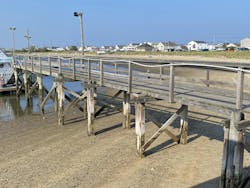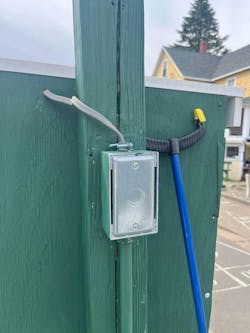All references are based on the 2023 edition of the NEC.
Making Waves at the Beach
Waves in rigid PVC conduit are not the kind of waves you expect to see at the beach, but the lack of expansion fittings and too few conduit clips have caused this conduit run to become a wavy mess. Table 352.30(B) requires the maximum spacing between supports for rigid PVC conduit to be limited to 3 ft for conduits of trade sizes 1/2-in. through 1-in. The clips used to support this conduit run are spaced way too far apart. That one violation by itself can cause the conduit to droop and sag. Now, add the lack of an expansion fitting as required by
Sec. 352.44(A), and the sagging and drooping problem increases dramatically.
Long, straight PVC conduit runs like this one can experience surprisingly large changes in length due to thermal expansion and contraction. For example, according to Table 352.44(A), a 100-ft run of PVC conduit could experience a length change of approximately 4 in. as the seasons change from a cold winter day to a hot summer day and back again. That is an amazing change in length and could potentially cause the conduit run to self destruct if expansion fittings are not used to accommodate that length change.
A Not-So-Weatherproof Installation
Waves in rigid PVC conduit are not the kind of waves you expect to see at the beach, but the lack of expansion fittings and too few conduit clips have caused this conduit run to become a wavy mess. Table 352.30(B) requires the maximum spacing between supports for rigid PVC conduit to be limited to 3 ft for conduits of trade sizes 1/2-in. through 1-in. The clips used to support this conduit run are spaced way too far apart. That one violation by itself can cause the conduit to droop and sag. Now, add the lack of an expansion fitting as required by
Sec. 352.44(A), and the sagging and drooping problem increases dramatically.
Long, straight PVC conduit runs like this one can experience surprisingly large changes in length due to thermal expansion and contraction. For example, according to Table 352.44(A), a 100-ft run of PVC conduit could experience a length change of approximately 4 in. as the seasons change from a cold winter day to a hot summer day and back again. That is an amazing change in length and could potentially cause the conduit run to self destruct if expansion fittings are not used to accommodate that length change.
About the Author

Russ LeBlanc
Owner
Russ started in the electrical trade as an apprentice in 1985. He worked his way up to become a Journeyman Electrician and then eventually became a Master Electrician and Licensed Construction Supervisor. In 1999 Russ become an Electrical Instructor for The Peterson School of Engineering in Massachusetts where he developed his passion for teaching, and quickly became Department Head of Electrical Instruction. Russ has taught thousands of apprentices, electricians, engineers, inspectors, and other electrical professionals during his career as an instructor. He continues to provide electrical professionals with Electrical Code seminars, Arc-Flash Awareness training seminars and educational material through his LeBlanc Consulting Services in North Reading, MA whose specialty is educating electricians. He has been an active member of the NFPA Electrical Section and has authored hundreds of National Electrical Code proposals and comments which have become Code rules to improve the safety for the electrical industry. Russ is also an IAEI certified Electrical Inspector.
Please visit www.russleblanc.net for more information.


